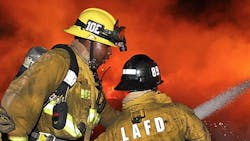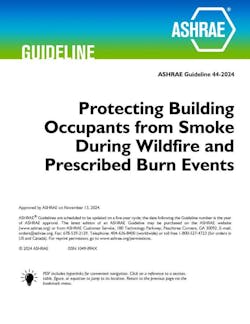LA Wildfires: NFPA, ASHRAE, ACEC Respond
PRESS RELEASES
January 10, 2025 -- In response to the ongoing wildfires affecting Southern California, the National Fire Protection Association (NFPA), the American Society of Heating, Refrigeration and Air-conditioning Engineers (ASHRAE), and the American Council of Engineering Companies (ACEC) have issued the following statements and made these resources publicly available.
NFPA
NFPA is providing information and resources for journalists covering these wind-driven fires.
According to NFPA, winds don’t necessarily cause wildfires, but wind-driven wildfire can happen just about anywhere. High winds exacerbate the risk because they add oxygen to the fire, which increases its intensity, and helps to move fire very rapidly through vegetation. They also loft embers for a mile or more ahead of the fire front.
“We can’t control the wind, but we can modify fuels, whether those are grasses, shrubs, forests, or our homes and their immediate surroundings,” said Michele Steinberg, director of the NFPA wildfire division. “That’s where efforts to prepare homes and neighborhoods in advance can make a substantive difference in reducing their susceptibility to wildfire.”
- There are more than 45 million homes in the wildland/urban interface (WUI), areas that are at high risk from destruction by wildfires. These statistics underscore that the U.S. is facing a wildfire crisis.
- Between 2014-2023, wildfires have destroyed more than 80,000 structures in the U.S., the majority of which were homes. Record high temperatures, drought conditions, and high winds from severe weather events have been blamed for increased wildfire activity in high-risk areas in the U.S., Canada, and Europe.
Available resources:
Expert interviews:
- Michele Steinberg, director of the Wildfire Division at NFPA, oversees national policy, development regulations, and community safety, and supports wildfire-related projects that cover a broad spectrum of safety education, advocacy, training, and certification.
- Megan Fitzgerald-McGowan, program specialist and former wildland firefighter, is responsible for the management of the Firewise USA® recognition program.
- Curt Floyd, senior specialist and technical lead for Engineering Technical Services at NFPA, oversees NFPA standards that address the needs of the fire service and emergency responders.
Subject matter expertise:
- Reducing wildfire risks around homes and in neighborhoods.
- Firewise USA® recognition program that empowers residents to work collaboratively in reducing wildfire risks.
- Outthink Wildfire™, a comprehensive strategy that lays out five key policy changes that need to be made at the federal, state, and local levels and, if followed, will end the destruction of communities by wildfire over the next 30 years.
- Fire department needs for wildfire response.
Additional information, resources, and articles:
- Prepare Your Home for Wildfire Fact Sheet
- Home Ignition Zone Checklist
- Wildfire Preparedness Tips
- NFPA Journal, May 2023 Wildfire Column: Inflection Point
For additional resources and information, and to learn more about how to keep families safe and reduce homeowners’ risk for wildfire damage, please visit NFPA’s wildfire division webpage.
ASHRAE
ASHRAE is providing free public access to a read-only version of the new ASHRAE Guideline 44-2024, Protecting Building Occupants From Smoke During Wildfire and Prescribed Burn Events (bit.ly/4gUL8hF), available until Feb. 11, 2025. This Guideline offers vital tips for creating safer, healthier indoor environments during and after fire events.
Additionally, ASHRAE Journal podcast episode “Where There’s Smoke, There’s HVAC” (bit.ly/44RPRKn) explores the impacts of wildfire smoke on buildings, people and public health. Our thoughts are with everyone affected by this tragedy and we hope that the resources and expertise of the ASHRAE community can provide meaningful support in the recovery process.
#####
ACEC
From ACEC's blog The First Word:
The ongoing wildfires in Los Angeles have wrought unprecedented devastation, with over 27,000 acres scorched and thousands of structures, including homes, reduced to ashes. Tragically (as of January 10), at least ten lives have been lost, and tens of thousands have been forced to evacuate.
Our thoughts are with the victims, their families, and the brave first responders tirelessly battling the blazes. The resilience and unity displayed by the community are truly inspiring.
Beyond immediate relief efforts, the engineering industry will play a critical role in the rebuilding effort, helping to restore communities and enhance infrastructure resilience against future disasters. Civil and structural engineers will be at the forefront of reconstructing homes, roads, and public utilities with a focus on fire-resistant designs and materials. Additionally, environmental engineers will work on restoring the damaged landscape, improving soil stability, and addressing air and water quality concerns caused by the fires.
The rebuilding process presents an opportunity to implement advanced technologies, such as smart fire-detection systems and sustainable building materials, ensuring that communities emerge stronger and more prepared for future challenges. By incorporating lessons learned from these wildfires, engineers can help shape safer and more resilient cities.
For those looking to assist, several organizations are actively providing relief and support to those affected:
- American Red Cross: Offering shelter, food, and comfort to victims. Donations can be made directly through their website.
- Los Angeles Fire Department Foundation: Supplying firefighters with essential equipment and resources. Contributions help ensure they have the tools needed to combat these fires effectively.
- California Community Foundation's Wildfire Recovery Fund: Providing both immediate and long-term support for wildfire recovery efforts, including rebuilding homes and mental health services.
- Los Angeles Regional Food Bank: Distributing food to those displaced by the wildfires. Donations assist in ensuring no one goes hungry during this crisis.
- Baby2Baby: Delivering essential items like diapers, clothing, and necessities
- Pasadena Humane Society: Caring for animals displaced or injured by the fires and seeking foster homes for pets in need.
As always, we strongly recommend that you do your research on any charity organization accepting donations in the wake of disaster. Charity Navigator and Guidestar are two groups that can help find reputable organizations.
The road to recovery will be long, but with the collective efforts of relief organizations, engineers, and the community at large, Los Angeles will rise from the ashes stronger and more resilient. Your support—whether through donations, volunteering, or spreading awareness—can make a significant difference in the lives of those impacted by this disaster.
Let us come together to aid our fellow citizens in their time of need, ensuring that the rebuilding process not only restores what was lost but also fortifies it for the future.
For more, go to ACEC - American Council of Engineering Companies.
#####

